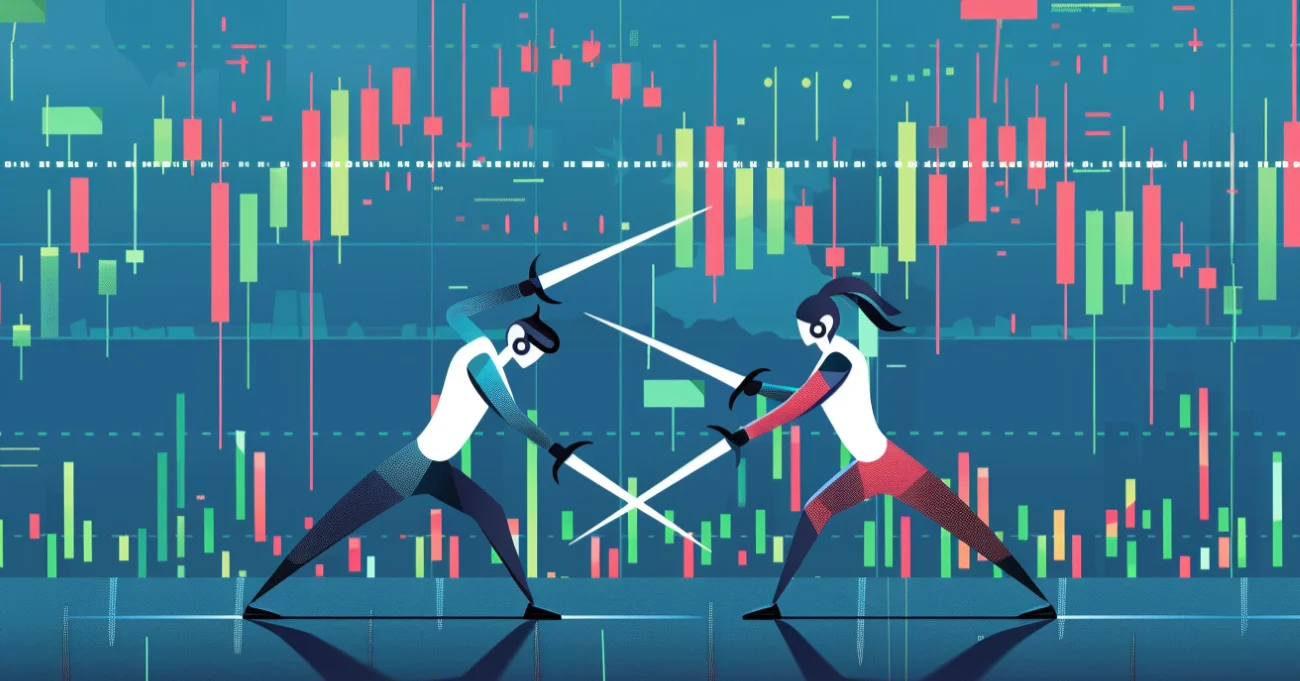
5+ Pros and Cons of Swing Trading: A New Trader’s Guide
Swing trading offers an appealing alternative to day trading and long-term investing strategies, significantly impacting the financial markets. Unlike other strategies, it aims to capture price trends and changes over a longer time frame. Understanding the pros and cons of swing trading is crucial as it combines technical and fundamental analysis elements, providing a trading style that suits trader experts or those seeking an active middle ground.
At Spartan Trading, we provide stock and options ideas to enhance your trading decisions. We understand the complexities of financial markets and use a mix of technical analysis and fundamental analysis to guide our members. From managing risk with stop-loss orders to exploiting short-term price fluctuations, our insights will help you navigate the stock market more effectively.
Reflecting on our expertise and insights, we’ve put together this guide to delve into the pros and cons of swing trading. Here, we will explore essential aspects such as the suitable time frame for swing trades, the importance of a solid trading plan, and how swing trading strategies can maximize trading opportunities while managing potential risks. Afterward, you will understand how to leverage market swings for profit while aligning with your trading style and risk tolerance.
Let’s get started!
What is Swing Trading?
Swing trading is a strategy that aims to capitalize on short- to medium-term price swings in financial assets. It typically holds positions for several days to weeks, allowing traders to take advantage of market fluctuations over a slightly more extended timeframe.
Here’s how swing trades work:
- Time Commitment: Swing trading requires less time on the computer screen than day trading. This allows traders to engage in online trading without monitoring the markets daily.
- Technical Indicators: Traders use tools like moving averages, average crossovers, and support levels to predict future price action and determine the overall trend. These indicators help identify the optimal entry and exit points.
- Risk Management: Effective stop loss and hedging strategies ensure minimal losses. This is crucial as only some trades will move in the desired direction due to fluctuating market conditions.
- Profit Potential: Swing trading allows traders to capitalize on significant price changes over several days, resulting in higher profits than on a trading day.
- Flexibility: The time frame for swing trading suits individuals who can dedicate even a small amount of time to watch the market but still wish to participate actively.
In essence, swing trading offers a balanced approach, combining short-term gains’ best elements with long-term investments‘ reduced time commitment. It’s a good idea for those looking for an alternative to the fast pace of day trading. It offers substantial profit potential through strategic trades that leverage market trends and price movements.
Watch our video to delve deeper into this trading strategy and learn how it can enhance your investment approach.
Understanding the Pros and Cons of Swing Trading
Swing trading is a popular strategy to capitalize on short-term price movements toward achieving significant gains. However, traders exploring this method must carefully evaluate the pros and cons of swing trading to determine if it aligns with their investment goals and risk tolerance. Here are the points to consider:
Pros of Swing Trading
Understanding the pros of swing trading is essential for informed decision-making in the volatile world of financial markets. Since swing traders take advantage of short-term price movements, relying on this trading strategy enables a leeway for quicker profits. Let’s delve deeper into pros.
Flexibility
One of the primary pros of swing trading is its flexibility. Unlike day trading, which requires constant monitoring of the markets throughout the day, swing trading allows traders to participate in the market without needing to be glued to their screens. This flexibility is beneficial for individuals with busy schedules or other commitments, as they can conveniently analyze the market and execute trades.
Potential for Higher Returns
Another significant advantage of swing trading is the potential for higher returns than traditional buy-and-hold investing. With short-term price movements, swing traders can capture profits more frequently that can potentially lead to faster portfolio growth. Additionally, swing trading strategies often incorporate risk management techniques to optimize risk-adjusted returns, further enhancing the potential for profitability.
Opportunity to Diversify
Swing trading benefits investors by diversifying their trading strategies and portfolios. Since swing traders focus on short- to medium-term price movements, they can capitalize on opportunities in various market conditions, including bullish and bearish trends. This diversification can reduce overall portfolio risk and enhance long-term performance by mitigating the impact of market volatility.
Cons of Swing Trading
Despite its allure, swing trading comes with its fair share of drawbacks. Understanding the cons of swing trading is crucial for anyone considering this investment strategy. Here, we will delve into the disadvantages of swing trading and provide insights into each.
Lack of Predictability
One of the primary cons of swing trading is the inherent unpredictability of the market. While swing traders aim to capitalize on price movements, the market’s volatility can often lead to unexpected outcomes. Unlike long-term investors who can weather short-term fluctuations, swing traders must constantly monitor the market and be prepared to act swiftly. This lack of predictability can result in significant losses if trades are not carefully executed.
High Transaction Costs
Another downside of swing trading is the accumulation of high transaction costs over time. Because swing traders execute frequent trades, they are subject to increased brokerage fees, commissions, and other trading expenses. These costs can eat into profits and diminish overall returns, especially for those with smaller trading accounts. Additionally, the constant buying and selling of securities can increase taxes for taxable accounts, further reducing net gains.
Time-Consuming
Another drawback of swing trading is the time commitment it requires. Unlike long-term investing, which typically involves less frequent trading activity, swing trading demands constant market monitoring. Traders must be vigilant in tracking price movements and market trends to capitalize on short-term opportunities effectively. This can be challenging for individuals with other professional or personal commitments, as it may necessitate dedicating a significant portion of their day to trading activities.
Swing Trading Strategies
Swing trading occupies an ample space in the investing world, balancing the rapid movements of day trading with the patience of long-term strategies. This approach suits those who can handle market volatility and are ready to invest time in studying market trends.
Let’s explore the seven best swing trading strategies and understand how they function effectively.
Fibonacci Retracement
Fibonacci retracement uses horizontal lines to identify potential reversals in the market price movement. Traders apply this strategy to establish strong support or resistance levels. These levels are crucial for setting up entry and exit points in trading, especially in volatile markets where predicting price movements becomes pivotal.
Support and Resistance
The support and resistance strategy identifies the price points at which a stock historically stops and reverses. These points act as barriers where the price of a stock struggles to break through. Swing traders use these markers to make informed decisions about buying at support levels and selling at resistance levels, capitalizing on predictable price movements.
Bollinger Bands Method
Bollinger Bands are a technical analysis tool defined by a set of trendlines plotting two standard deviations (positively and negatively) away from a simple moving average (SMA) of a stock’s price. The bands widen or narrow based on the market’s volatility, giving traders insights into market dynamics. This method helps identify overbought or oversold conditions, allowing traders to make strategic buying or selling decisions.
Trend-Catching Strategy
This strategy involves identifying the direction of the market trend and effectively riding it. Swing traders look for signals that a trend is setting and open positions to profit from this momentum. It requires patience and a keen eye for market movements, as exiting too early or too late can impact potential gains.
Breakout Swing Strategy
The breakout strategy targets price movements that break through a defined resistance or support level with increased volume. This strategy suggests a significant move upwards or downwards is about to occur, and traders position themselves to capitalize on this momentum. Accurate identification of breakouts combined with high volume can lead to substantial profits.
Breakdown Swing Strategy
Contrary to the breakout strategy, the breakdown strategy focuses on selling at the sign of a downturn. When prices drop below a defined support level, swing traders might take a short position and anticipate a further decline. This approach requires careful monitoring of market trends and a readiness to act quickly on downward movements.
Fading Trading Strategy
Fading involves betting against the prevailing market trend. This high-risk, high-reward strategy suits experienced traders who can identify potential peaks or troughs in stock prices before they reverse. The key to success here is timing and the ability to withstand market pressures against the trader’s position until the reversal happens.
Common Mistakes to Avoid in Swing Trading
A precise execution and an acute understanding of market dynamics is essential swing trading. However, certain common mistakes can undermine its effectiveness, impacting the potential gains. Understanding these pitfalls is as crucial as knowing the pros and cons of swing trading.
Neglecting Proper Research
One of the most common errors traders make is neglecting the necessary research before entering trades. Swing trading relies heavily on technical analysis to identify potential entry and exit points. Traders who skip this step might miss critical trend reversal or continuation indicators. It’s essential to analyze market conditions thoroughly and not rely solely on speculative or anecdotal evidence.
Failing to Set Stop-Loss Orders
Another significant oversight is not setting stop-loss orders. These are crucial for managing risk and preventing large losses if the market moves against your position. A well-placed stop-loss order ensures that your losses remain within acceptable limits, protecting your capital from unexpected market fluctuations. Traders often hope for a rebound in price without practical safeguards, leading to increased losses.
Overlooking Market Volatility
Ignoring market volatility can be detrimental to a swing trader’s portfolio. Volatility can significantly affect swing trading strategies, as sudden market changes can quickly turn a profitable trade into a loss. Traders must be aware of economic reports, news events, and other factors that can cause market volatility and adjust their strategies accordingly.
Overtrading
Overtrading is a trap many new traders fall into, driven by the desire to capture every possible market movement. However, too many trades can increase transaction costs and diminish overall profitability. Moreover, it can lead to burnout and decision fatigue, impairing a trader’s ability to perform. Swing traders should focus on quality trades over quantity, selecting only those setups that meet all their strategic criteria.
Relying on Excessive Leverage
Using excessive leverage is one of the riskier mistakes in swing trading. While leverage can amplify returns, it also increases the potential for significant losses, especially in volatile markets. Traders should use leverage cautiously and ensure they have adequate risk management strategies in place to handle potential drawdowns.
All in all, understanding the benefits and drawbacks of swing trading is crucial for anyone pursuing this trading approach. Implementing these practices will help stabilize your trading strategy and yield more consistent results.
Key Takeaway
Swing trading offers unique advantages and challenges that require careful consideration of the pros and cons of swing trading. This method allows traders to exploit market momentum over several days to weeks, potentially leading to significant gains. However, this approach demands a solid understanding of market trends and technical analysis. Traders must weigh these factors to develop a balanced view of swing trading’s viability for their personal investment goals.
New traders should approach swing trading with an informed and cautious mindset. Analyzing the pros and cons of swing trading helps determine if this trading style aligns with your financial objectives and goals. With the proper preparation and mindset, swing trading can be a rewarding strategy, but it is vital to be well-informed about the expected risk-return tradeoff.
Ready to elevate your trading with a strategy that fits your resources and goals? Subscribe to our newsletter for the latest tips and strategies in swing trading. Contact us at Spartan Trading for more insights and to learn about our Swing Trading Program. Don’t miss out on these opportunities so you can enhance your trading skills and knowledge!







